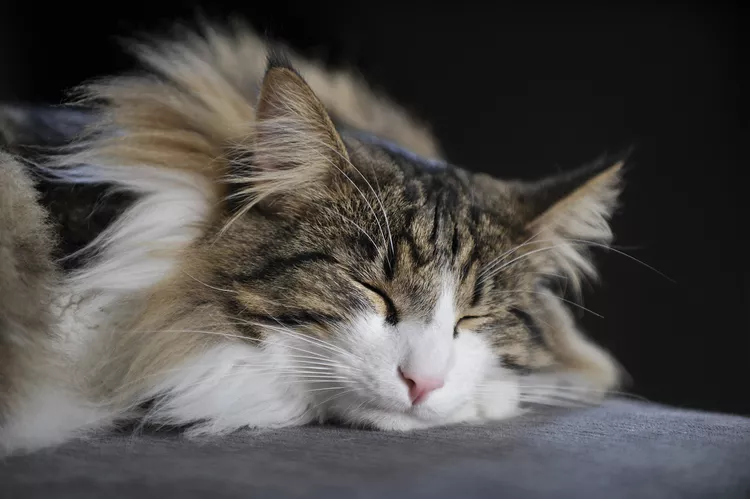- 01 of 07
Norwegian Forest Cats Have Interesting Origins
Although the Norwegian forest cat makes frequent appearances in Norse legend, its origins are a bit of a mystery—and surprisingly war-like. Here are the two major origin theories in the books:
- Wegies could be related to British black and white short-haired cats that Vikings used as mousers on their ships and eventually brought to Scandinavia.
- They're descendants of long-haired cats that the Crusaders brought to Scandinavia.
Whether Norwegian forest cats descended from short-hairs or long-hairs, it's widely accepted that these early relatives lived in Norway's forests after arriving in Scandinavia. There, they bred with feral and farm cats. And after several generations of breeding, they became the large, winter-ready kitties we know (and cuddle) today.
Continue to 2 of 7 below - 02 of 07
They're Legendary—Yes, Really
As we said, Norwegian forest cats come up in Norse folklore often. Old myths describe the skogkatt, a massive, long-haired "mountain-dwelling fairy cat" that could climb surfaces no other cat could manage. Considering their size, long, shaggy coats, and amazing climbing abilities, these legends very well could have been inspired by Norwegian forest cats.
What's more? It's believed that the Norwegian goddess of love and fertility, Freya, had a chariot pulled by two Wegies. People who wanted to marry would ask Freya for her blessing, and because she was often depicted with Norwegian forest cats, several myths linking weddings with cats developed:
- Gifting newlyweds with a black cat would bring good luck to their marriage (that's good).
- If a bride fed a cat just before her wedding ceremony, she'd have a long, happy marriage (that's good).
- If you stepped on a cat's tail, you wouldn't marry for a whole year (that's bad).
Even though these are just superstitions, they do a lot to remedy the caricature of a sad, single cat lady, right?
Continue to 3 of 7 below - 03 of 07
They Have Built-In Winter Wear
Because they originated in a cold climate with long winters, Norwegian forest cats developed built-in winter wear to help them survive the harsh weather. Not only do they have long, double-layered coats that retain warmth and repel water, but their ears and toes are tufted, too. These fluffy tufts protect the more sensitive parts of their bodies from cold winds and wet snow by acting like tiny, furry ear muffs and boots (aw!).
Continue to 4 of 7 below - 04 of 07
They Love to Climb Trees
If "forest" is in their name, they should be pretty adept at living in the forest, right? Because their early ancestors lived in Norway's forests—and often hunted and lived in their trees—Norwegian forest cats have extremely strong, thick claws that allow them to dig into tree bark and easily scale trees. What's most impressive? Wegies are just as good as climbing down trees as they are climbing up.
Continue to 5 of 7 below - 05 of 07
They're Norway's National Cat
That makes sense, right? Norwegian forest cats were declared the national cat of Norway by King Olaf. Their legendary status in Norse folklore, thick, winter-ready coats, and interesting origin stories make them the ideal Viking kitty representative for the snowy Scandinavian country.
Continue to 6 of 7 below - 06 of 07
They Almost Became Extinct
Back in the day, European sailors and farmers loved Norwegian forest cats for their excellent mousing skills, making them an extremely popular breed.
In the mid-1900s, however, interest in the breed waned, and cross-breeding nearly wiped out Wegies entirely. Fortunately, a preservation program was developed to save the breed and boost the number of Norwegian forest cats living across Europe. Then, in 1977, Norwegian forest cats were officially recognized as a breed by the Fédération Internationale Féline (Europe's equivalent to the Cat Fancier's Association).
Although Wegies have a long history in Europe, they didn't come to the United States until 1979. Nearly a decade later, in 1987, they were officially accepted by the Cat Fancier's Association and received "full championship status" from the organization in 1993.
Today, Norwegian forest cats are among the most popular breeds in the United States.
Continue to 7 of 7 below - 07 of 07
They're Ancestors to Maine Coons
Nope, you're not imagining it. Norwegian forest cats and Maine coons share many similarities—especially their appearances. They're both very large, long-haired breeds, with thick, warm coats, and tufted ears and paws. So, it should come as no surprise that Wegies and Maine Coons are actually related! Genetic testing has determined that Maine Coons are descendants of Norwegian forest cats and a now-extinct American breed.
Although they look alike, there's one easy way to tell the two breeds apart: Norwegian forest cats have more narrow, triangle-shaped faces, while Maine Coons have wedge-shaped (or inverted triangle-shaped) faces.




















